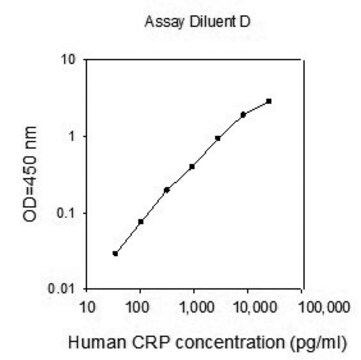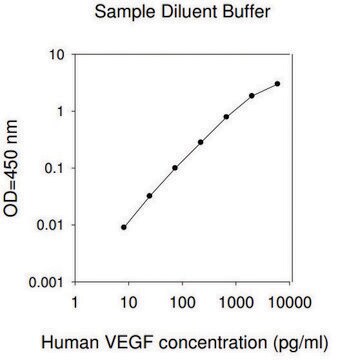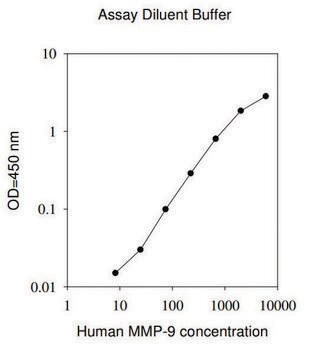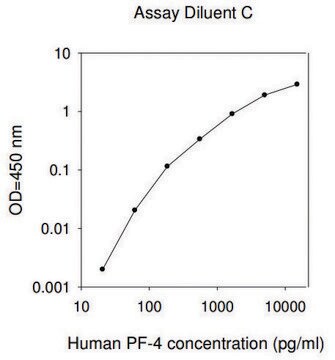About This Item
Kod UNSPSC:
41116158
NACRES:
NA.32
Polecane produkty
reaktywność gatunkowa
human
opakowanie
kit of 96 wells (12 strips x 8 wells)
metody
ELISA: suitable
moc wejściowa
sample type cell culture supernatant(s)
sample type serum
sample type plasma
assay range
inter-assay cv: <12%
intra-assay cv: <10%
sensitivity: 14 pg/mL
standard curve range: 16.38-4000 pg/mL
metoda wykrywania
colorimetric
Warunki transportu
wet ice
temp. przechowywania
−20°C
informacje o genach
human ... SDC1(6382)
Powiązane kategorie
Opis ogólny
Para przeciwciał dostarczona w tym zestawie rozpoznaje ludzki Syndecan-1/CD138.
Zastosowanie
For research use only. Not for use in diagnostic procedures.
Please refer to the attached General ELISA KIT Procedure (sandwich, competitive & Indirect ELISA)
Please refer to the attached General ELISA KIT Procedure (sandwich, competitive & Indirect ELISA)
Inne uwagi
Dla tego produktu dostępny jest przykładowy certyfikat analizy.
Wpisz słowo sample w polu tekstowym przeznaczonym na numer partii.
Wpisz słowo sample w polu tekstowym przeznaczonym na numer partii.
Ta strona może zawierać tekst przetłumaczony maszynowo.
Hasło ostrzegawcze
Warning
Zwroty wskazujące rodzaj zagrożenia
Zwroty wskazujące środki ostrożności
Klasyfikacja zagrożeń
Met. Corr. 1
Kod klasy składowania
8A - Combustible corrosive hazardous materials
Temperatura zapłonu (°F)
Not applicable
Temperatura zapłonu (°C)
Not applicable
Wybierz jedną z najnowszych wersji:
Masz już ten produkt?
Dokumenty związane z niedawno zakupionymi produktami zostały zamieszczone w Bibliotece dokumentów.
Lawrence N Diebel et al.
The journal of trauma and acute care surgery, 84(4), 575-582 (2017-12-30)
Early resuscitation after trauma-hemorrhagic shock with plasma rather than crystalloid may ameliorate systemic endothelial cell (EC) injury and dysfunction (endotheliopathy of trauma). We postulated that endothelial-lined microfluidic networks would be a useful platform to study the EC activation/injury under flow
Mark E Diebel et al.
The journal of trauma and acute care surgery, 84(1), 75-80 (2017-10-19)
The endothelial glycocalyx (GCX) plays an important role in vascular barrier function. Damage to the GCX occurs due to a variety of causes including hypoxia, ischemia-reperfusion, stress-related sympathoadrenal activation, and inflammation. Tranexamic acid (TXA) may prevent GCX degradation. The therapeutic
Jonathan V Martin et al.
American journal of surgery, 214(6), 1166-1172 (2017-10-05)
Geriatric trauma patients have high circulating norepinephrine (NE) levels but attenuated release of epinephrine (Epi) in response to increasing severity of injury. We hypothesized that NE and Epi have different effects on the endothelial and glycocalyx components of the vascular
Josephine Koch et al.
American journal of physiology. Renal physiology, 316(1), F121-F127 (2018-11-01)
Syndecan-1, a transmembrane heparan sulfate proteoglycan, associates with renal and cardiovascular functioning. We earlier reported syndecan-1 to be involved in renal tubular regeneration. We now examined plasma values of syndecan-1 in a hemodialysis cohort and its association with volume and
Kohji Uzawa et al.
Journal of anesthesia, 34(1), 36-46 (2019-10-17)
Fluid therapy focused on glycocalyx (GCX) protection in hemorrhagic shock is a current focus of research. Hydroxyethyl starch (HES) solution is commonly used for fluid resuscitation; however, its effects on the GCX remain unclear. The primary aim of this study
Nasz zespół naukowców ma doświadczenie we wszystkich obszarach badań, w tym w naukach przyrodniczych, materiałoznawstwie, syntezie chemicznej, chromatografii, analityce i wielu innych dziedzinach.
Skontaktuj się z zespołem ds. pomocy technicznej









